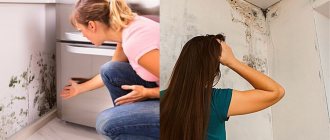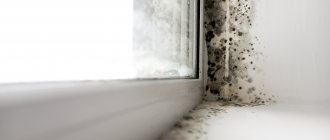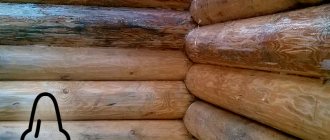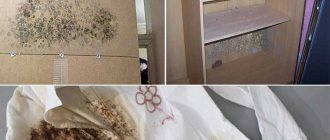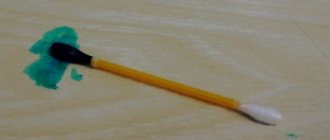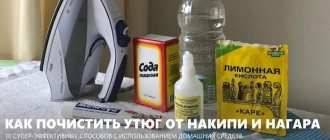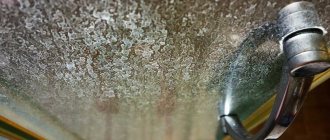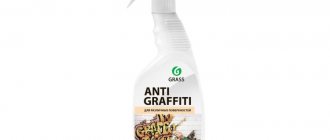Just a couple of centuries ago, mold in a room was perceived as a warning that it was necessary to burn down this very home. It’s good that in our time we don’t have to resort to such radical measures. And although the appearance of such a fungus in the house is very unpleasant, it is quite possible to remove it. In this article you will learn how to get rid of black mold: we will take a closer look at some of the most effective ways to combat the fungus.
How to get rid of black mold - tips
Mold: what is it and why is it dangerous?
This is the name given to Aspergillus fungi, microorganisms that cause aspergillosis (infections in living beings).
Aspergillus mushroom under a microscope
At first glance, it is not always possible to assess the full extent of the danger of black mold to humans. However, even with short-term contact it causes significant harm to our health, and with longer exposure the negative impact increases significantly.
Note! Almost one hundred million spores are released per square meter of mold within an hour. Two or three years is the period during which the fungus destroys the concrete partition.
Why is black mold dangerous in the home
? People with weak immune systems, pregnant women, children and the elderly should especially be wary of it. Even wearing a mask, you cannot protect yourself from harmful fungi: spores “hover” in the air, enter through the skin, and settle on food.
Table 1. Danger of black mold to humans.
| Ailments with short-term exposure | Illnesses caused by prolonged exposure |
| · skin itching, allergies; · tearfulness; · nosebleeds; · nervousness; · cough (usually dry); · problems with the gastrointestinal tract; · migraine; · swelling of the mucous membranes. | · serious lung diseases (asthma, pneumonia); · weakening of motor function of the limbs; · decreased level of immunity; · poisoning; · increased symptoms of existing chronic diseases; · impetus for the development of oncology; · convulsions. |
Skin diseases that arise may be a consequence of the presence of black mold in the room
Historical fact. There are known cases of death in people who have had contact with black mold. Mass death (20 people) was caused by fungal spores that filled the tomb of the great Tutankhamun: the philanthropist Lord Carnarvon and some members of the research team died shortly after being in the burial place. Scientists have found that the reason for the archaeologists’ death was precisely the fungus that densely filled the tomb over three millennia.
Video - The danger of black mold to humans
Reasons for appearance
Of course, such a harmful type of microorganism may not appear everywhere. Favorable conditions are necessary for their reproduction. Your home and you are at risk if:
- no ventilation in the room;
- there is condensation arising from temperature fluctuations;
- high degree of humidity;
- irregular (very rare) ventilation;
- poor heating quality (frozen walls);
- the presence of leaks in sewerage or heating systems;
- leaky joints between walls;
- leaks from the upper floors.
The main impetus for the appearance of black mold is a prolonged increase in humidity.
To effectively combat the fungus, it is important to find out and eliminate the cause of its appearance.
Where does it appear?
Aspergillus is a fairly unpretentious resident, which makes it almost ubiquitous. However, there are surfaces on which the appearance and active proliferation of fungus is most likely. There are several of them.
- Plastic. PVC windows store heat, have a high degree of sound insulation and at the same time are excellent for the life of black mold (moisture does not evaporate).
If PVC windows are constantly closed, the appearance of fungus cannot be avoided - Drywall. The material is convenient and popular in construction, but it absorbs moisture, which does not evaporate. It is important to follow the installation technology here: slabs that are not completely dried will become a source of mold.
Mold on drywall - Concrete. Most often these are floors (floors, walls). If designers or builders make mistakes, the joints between walls, especially corners, are exposed to precipitation and cold.
Mold on the walls - Technique. These are appliances that come into contact with moisture: refrigerator, washing machine, split system/air conditioner, air humidifiers. If these devices are used incorrectly, there is a possibility that black mold will settle there too. It is advisable to keep the equipment dry; wipe wet parts often.
Mold in the washing machine - Wardrobe items. This will happen if the laundry is stored in sealed boxes or damp cabinets. Most often, we simply break the rule of dryness: under no circumstances should we put away things that are not completely dried!
Fungus can even appear on clothes
Professional products
How to get rid of black mold on walls yourself? If folk remedies for fungi do not bring the expected positive effect, then you should pay attention to professional remedies. They will cost a little more than using simple soda or vinegar, but manufacturers promise 100% results. Among the most popular means are the following:
- Anlas Mykos is a powerful and effective remedy that can help get rid of even outdated and overgrown mold colonies.
- Profilux is a drug that has an effective effect on mold that has affected wooden surfaces.
- “Antisept” is a Russian-made product that is widely used for antiseptic preventive treatment of surfaces at the repair stage.
- Schimmel Vernichter helps eliminate mold on all types of surfaces. It is highly effective against most known varieties of fungi.
Since professional mold removal products are highly concentrated, it is recommended to use protective equipment such as a respirator and rubber gloves.
Types of black mold
Aspergillus is a large genus of microorganisms with several species. Each of them can be classified as black mold, but the places where they appear and the degree of impact on humans will be different.
- White mycelium with black spores . Found in toilets and infects food. Toxic, promotes colds, allergic reactions and even cancer.
- Aspergillus fuming. Present on damaged vegetables, fruits, and grains. The spores enter the body, where they infect red blood cells and greatly reduce immunity.
Genus Aspergillus - Ulocladium . Lives in mattresses, sheets, toilets. Can provoke candidiasis, vaginitis, kidney and liver diseases. The insidiousness of the fungus lies in its “invisibility” - tests often do not show its presence in the body.
- Cladosporium (“kerosene mushroom”). It affects a wide range of objects: food, window frames, soil (house plants), household appliances (refrigerator), face and hand care products, clothing, house walls, fuels and lubricants. Promotes the development of severe allergies at any age, skin lesions (eczema, dermatitis).
Cladosporium - Black mycelium with white spores (“black rot”). It loves wooden or plastered surfaces, but is practically never found in residential buildings.
- Penicillium. Appears mainly in products: grains, cereals, dried apricots, prunes, coffee. Fungal spores are dangerous for children - they sharply suppress the immune system due to the harmful substance ochratoxin.
Penicillium - Khetomy . It can appear and begin to reproduce on any surface. It is dangerous if it gets inside a person (with food): it causes poisoning, in severe cases there is a possibility of death.
- Alternaria . It has not only black, but also gray tint. Occurs on spoiled fruits, vegetables and grains, rotted leaves, and meat. From contact with a strain of these fungi, a person can expect the appearance of itching, runny nose, dermatitis and severe asthma src=»https://stroyday.ru/wp-content/uploads/2019/05/Alternaria.jpg» class=»aligncenter» width= "1024″ height="768″[/img] Alternaria
- Wallemia sebi is a fungus that does not like moisture; on the contrary, it prefers dryness and warmth. It is difficult to remove, but does not pose a danger to humans.
Getting ready to fight mold
Before you begin to directly remove a colony of fungi, you should carefully prepare for this procedure. This will help get rid of black mold with the greatest efficiency.
- Determine the location of harmful microorganisms: sniff, look at all surfaces, especially places hidden from view.
- Take plastic film and block the ventilation with it. This will help prevent the spread of mold spores.
Open all windows - Wear a mask or respirator, protect your eyes with goggles, and your hands with household gloves.
- Buy a special brush with metal bristles - it removes mold perfectly.
Metal bristle brush - Be prepared that some affected areas will have to be replaced. Drywall and wallpaper will lose their former appearance after mechanical impact.
Important! Before cleaning, take care of house plants and pets; it is best to remove them from the premises. Food must also be isolated.
How to remove black mold?
If a large surface of the wall is affected by a black coating, then repairs are required. In situations where dark spots are just beginning to appear, they are destroyed with potent drugs. The products can be industrially produced or prepared independently. First, thoroughly clean the wall from visible black spots. To do this, wash it with warm soapy water using a brush or hard sponge. When the surface is dry, generously apply the chemical solution to the walls. The procedure must be repeated several times, even if the fungal spots have disappeared after the first application. When working, you should remember about safety precautions. Be sure to wear a protective mask, special glasses, and rubber gloves.
Mold in the washing machine: diagnosis or death sentence?
Review of black mold removers
Today there are a lot of options for getting rid of Aspergillus fungi. These include various chemicals and folk remedies. There are also specialized services that help correct a very deplorable situation. If the scale of the tragedy is not too great, you can try to cope on your own. Below we will look at the most popular and effective means for combating black mold.
Folk remedies
Very often we give preference to folk remedies. It’s hard to argue that they are less toxic and less dangerous for people. But are they equally good at removing black mold from concrete, wood or plastic? Of course, not every homemade fungicide will be a weapon of mass destruction of the fungus, but there are known means that help destroy the enemy perfectly. We will consider the strongest ones below.
- Copper sulfate (100 g) + water (10 l). This product should be applied to the damaged area and left for 3 hours. Why rinse the surface thoroughly?
Vitriol works especially well against mold in the bathroom - A mixture of essential oil (bergamot / lemon balm / lavender / tea tree) with water in a proportion of 1 tsp. for 250 ml.
- Hydrogen peroxide 3% + water (1:2).
Any 3% peroxide will do - Formalin slightly diluted with water.
- A mixture of borax, water and vinegar (100 g: 950 ml: 120 ml).
- Water + baking soda (1:1).
Baking soda is great for wood surfaces - A mixture of 1 part ammonia and 1 part water.
- Water + chlorine (1 l: 50-60 ml).
You can choose white, in which case you won’t need to dilute it with water.
All of the listed home recipes can help get rid of the problem. To influence the enemy for sure, you need to perform the following manipulations:
- Mix warm water with kitchen utensil cleaner (2 l: 2 tbsp).
- Stir until the foam becomes thick.
- Using a stiff sponge or brush, apply to the contaminated surface.
Treat the moldy area - Rub until completely covered with foam.
- Wipe the surface with a clean cloth.
- Apply the chosen product and leave for half an hour.
- Thoroughly clean the surface with a wire brush or scraper.
Cleaning mold areas - Rinse with clean water.
- Wipe with a dry cloth and dry with a hairdryer.
- Treat the area with an antiseptic (“Nortex”, “Ceresite”, “Capatox”, etc.).
- If we are talking about walls, then after all the steps they need to be primed, plastered and covered with putty.
A hairdryer is an excellent assistant in drying treated areas
Important! If the amount of fungus on the surface is significant, treat 4-5 times with an interval of 3 days. In each procedure, wipe the cleaned area until completely dry.
Video - Getting rid of mold using folk remedies
Professional products
Store-bought fungicides are an excellent solution, especially if folk remedies are powerless. Among the large assortment, there are several of the most popular. Let's take a closer look at them.
- "Fongifluid ALPA". This is a fungicide that can be applied to the affected surface both indoors and outdoors. If the surface to be treated is rough, loose or porous, it is recommended to first level it (by sanding). In case of a large amount of mold, the procedure is carried out twice. The product is applied with a gun, roller or brush.
"Fongifluid ALPA" - "Biotol spray". This bioantiseptic is used in the kitchen, balcony, bathroom, and is also suitable for caring for monuments, tombstones and fences. For successful treatment, clean the surface with a scraper. Things, furniture, and interior items should be covered with film, and after cleaning, dry the treated area.
"Biotol-spray" - "Olympus stop mold." Copes well with infection in the dampest places, suitable for work in the bathroom, greenhouse, basement, cellar. The main advantage is the absence of toxins and safety for humans and pets. Any concrete, ceramic, wood, brick stone or drywall surface will be cleaned.
"Olympus stop mold" - "Dali." A very versatile product. Will cope with mold on wallpaper, windows, plumbing, brick, concrete, wood, painted walls, drywall, ceramics, tiles, varnished surfaces. It is popular because its effectiveness is high; it can even remove moss, algae, and mold of any kind.
Attention! Do not mix two different chemicals! For example, a fungicide with ammonia cannot be combined with bleach or other substances.
Ultraviolet radiation
A UV lamp can help in the fight against black mold. If you have one in your arsenal, then consider that the problem is solved: the radiation will destroy fungal spores. But do not forget to isolate your pets (even an aquarium with fish) and flowers so as not to harm them.
Ultraviolet lamp
Help from specialists
Sometimes even the best efforts to remove black mold from your home may prove futile. Then specialists – disinfectors – can help you. The efficiency of their work is quite high, because the destruction of infection is based on ozonation technology. Ozone penetrates into places where mushrooms accumulate and kills them. This works especially well when the mycelium is located in cracks in walls, under wallpaper, between joints.
How do you know when it’s time to call in specialists? You need to do this as soon as possible when:
- More than 3 square meters are infected. m. area;
- mold spreads rapidly;
- the appearance of fungus is the result of a sewerage break/flooding of the premises;
- there is a possibility of spores entering the ventilation.
In advanced cases, only specialists will help
How to repair a damaged room
You shouldn’t limit yourself to removing mold on a damaged wall in your apartment. For prevention, the house is completely treated: pathogenic spores are constantly contained in the air and, under favorable conditions, will begin to spread throughout the house.
Complete home renovation required
When renovating an apartment, much attention is paid to corners, interpanel seams, and places where walls meet the floor and ceiling: mold fungi live here. Intensively clean rooms where humidity may increase:
- bathroom;
- kitchen;
- toilet;
- balcony;
- basement.
First, visible stains and growths are destroyed, old coatings are removed down to the brick (concrete). Then the cleaned structures are impregnated with an antiseptic. After drying, they begin finishing and applying a waterproofing coating to the floor.
Additional Information! For plastering, it is worth using lime-cement mixtures, which are more durable, resistant to moisture and the formation of fungi than lime compositions.
Wall cleaning
Each wall is carefully treated. To remove mold on the wall, follow the following algorithm:
- Moisten the damaged area generously, covering adjacent areas to block the spread of spores.
- Clean the plaque: use a sharp spatula to remove wallpaper, contaminated layers of paint, and plaster. Use a stiff metal brush to remove the build-up.
- The concrete is impregnated with an antifungal compound: the anti-mold agent is evenly distributed on the walls, covering the surrounding areas that appear clean. If this rule is neglected, the structure may be re-infected.
- The second layer of the substance is placed on the dried first layer, then the third.
- To prevent re-injury, a protective agent is used.
After treatment, a healthy microclimate is created in the house to prevent the reappearance of micromycetes: they monitor cleanliness and temperature conditions, improve ventilation, and normalize air humidity.
Effective anti-mold agents
Reference! To prevent the spread of spores, affected wallpaper, remaining paint and plaster that have been removed are immediately destroyed.
How to remove fungus from bathroom walls
In the bathroom, mold on the walls often appears at the seams between the tiles or at the junctions between the walls and the plumbing. To destroy black deposits around the tiles, the affected areas are first cleaned with a metal scraper, then covered with antiseptic grout.
If the sealant near the connection between the plumbing and the wall becomes moldy, the contaminated silicone is removed and the damaged area is treated with an antifungal agent. After drying, the elastic mixture is reapplied.
To remove spores from the ceiling, the damaged area is moistened generously. After 1.5 - 2 hours, the plaster is cleaned off. Exposed irregularities are smoothed over with putty. When the coating dries, apply a primer containing fungicidal substances. The dried layer is impregnated with a penetrating primer. After drying, sanding and leveling the area, the surface is finished.
A leaky faucet and rusty pipes lead to the appearance of mold in the bathroom
Additional Information! If fungus has just appeared on the ceiling, lubricate the cleaned surface with any available product - aroma oil (eucalyptus, tea tree or rosemary), vinegar, soda or bleach. With intensive growth of the colony, special means are required.
How to get rid of mold in different parts of the room
We looked at general methods of combating the fungus Aspergillus. These recommendations, if followed, are quite effective. And yet, for the greatest effectiveness, it is always worth considering which surface requires treatment. Below we will give some tips for removing black mold from different objects and places in the house.
Table 2. Recommendations for removing mold from various surfaces.
| Location of black mold | Tools used | Removal recommendations |
| Bathroom, refrigerator | Vinegar essence / Hydrogen peroxide 3% | - pour the product into a spray bottle; - spray on areas of infection; - wait 10-15 minutes; - wipe with a clean cloth. |
| Laundry soap | - soap the sponge heavily; - actively apply to the site of infection; - rinse with warm water; - ventilate the room. The soap may leave an odor that goes away within two days. | |
| Baking soda | - mix with water (1 tsp: 1 l); - carefully treat the surface; - wipe and dry. Soda is often used as a means of prevention. | |
| "Domestos" | - act according to the instructions on the product; - rinse well. | |
| Window | Any chemical fungicide, as well as chlorine or copper sulfate + bleach | — remove the plastic trim of the window sill, rinse thoroughly; - clean the affected area; - dry the surface; - carry out treatment with the selected product; — if there are cracks and holes in the windows, seal them with sealant; — install the parts back. |
| Tea tree oil + water (1 tsp: 1 cup) | - treat the area with mold; - Rinse well and dry. | |
| Washing machine | Baking soda + hydrogen peroxide tablets (1 glass: 10 pieces) / White + vinegar / “Domestos” + citric acid | — place the selected product in the powder compartment; — start the machine to the 90 °C program; — when finished, wipe the drum and other parts of the machine dry (especially the filter); — ventilate the machine for 2-3 days. |
| Baking soda + 2 tsp. water | - apply the mixture to the machine parts; — pour a pack of dry soda into the detergent compartment; — start the wash cycle at 90 °C; — dry the removable parts and the drum. | |
| Fabrics | Lemon juice + onion | — chop the onion and mix with the juice of 2 lemons; - cover the affected area with the mixture, covering it with film; - wait 30-40 minutes, after which remove the mixture; - wash the item. |
| “Vanish”, “Domestos” and other special products | - use according to instructions. | |
| Vinegar essence + glycerin + water (45 ml: 25 ml: 1 l) | - soak the item in the resulting mixture for half an hour; - wash; - dry, limiting from exposure to direct sunlight. | |
| Turpentine | - thoroughly wipe the infected areas; — sprinkle with powder (unscented baby powder); - cover with a clean paper sheet and iron; - wash. | |
| Chalk (good for cotton fabrics) | - grind to a powdery state; - sprinkle the affected area; - cover with a white sheet and iron for 10 minutes; - wash. | |
| Laundry soap | - rub half a bar of soap and pour in 1.5 liters of water; - soak the item for half an hour; - wash. |
Tea tree essential oil can rid windows of fungus
Note! Hydrogen peroxide not only removes fungus, but also whitens. Use it exclusively on white surfaces!
Video - Removing mold from a linen closet
Other methods
How to get rid of black mold on walls? Reviews note that the following methods are also effective:
- A weak solution of potassium permanganate has excellent antiseptic properties. Unfortunately, potassium permanganate is difficult to find today, but many people still have old supplies.
- Grapefruit seed extract. You only need 10 drops per 1 glass of water. The resulting solution should be sprayed onto the affected areas. The extract not only destroys mold fungi, but also has a pleasant aroma.
- Lavender or rosemary oil has antiseptic properties. The method of application is similar to using grapefruit seed extract.
- Citric acid allows you to get rid of not only scale in the kettle, but also a small colony of mold fungi. To do this, you need to dilute the sachet with the substance in 1 glass of water, and then apply it to the affected areas using a sponge.
How to get rid of black mold on walls? In the fight against fungal infections, all means are good, since they are extremely dangerous to the life and health of the inhabitants of the home.
Removing the smell
Black mold is a source of not only infection, but also a very unpleasant odor that can remain in the room even some time after the fungus is removed. To get rid of this nasty odor, you need to do the following.
- Treat the cleaned area with a warm stream of air (hair dryer).
- Cover the area with baking soda and leave for 2 hours.
- Remove the soda.
There is another equally effective way: wipe the area where the mold was with a mixture of white vinegar, hydrogen peroxide, boric acid and water (2:2:1:4).
Wipe the cleaned area until the smell disappears completely.
We carry out prevention
Agree, it is always easier and cheaper not to eliminate the problem, but to prevent it. Therefore, it is necessary to periodically prevent the appearance of black mold in the house. Such measures include:
- regular ventilation;
- checking the proper operation of ventilation;
- checking the premises for fistulas, leaks, cracks and eliminating them;
- treating all existing building materials with special antiseptic agents (before repairs);
- eliminating holes and cracks in frames, if any;
- ventilation of the bathroom.
Fans for the bathroom
Important! Don't dry things in the bathroom!
Black mold is a dangerous enemy of humans, causing great harm to health. It is possible and necessary to fight it, but it is best not to start the problem and start solving it at a very early stage. Then victory will definitely be on your side.
Harm and danger
This type of fungus produces toxic substances and therefore leads to health problems even without direct contact with it. The first signs of mold affecting the body are difficulty breathing and coughing. A runny nose, irritation in the throat, dermatitis and eczema may occur. It is especially dangerous for people suffering from asthma; they may experience exacerbations.
We pay attention to the places that are most vulnerable in this regard:
- Kitchen
- Bathroom
- Basement
- Furniture (carpets)
- Cloth
- Log houses and timber lumber
